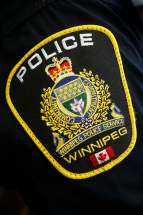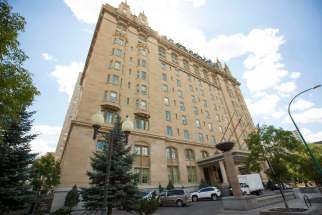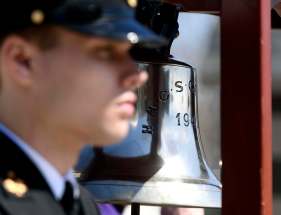Province to send kids back to school Plan includes flexibility for schools, divisions, but no new money or mandatory masks
Read this article for free:
or
Already have an account? Log in here »
To continue reading, please subscribe:
Monthly Digital Subscription
$0 for the first 4 weeks*
- Enjoy unlimited reading on winnipegfreepress.com
- Read the E-Edition, our digital replica newspaper
- Access News Break, our award-winning app
- Play interactive puzzles
*No charge for 4 weeks then price increases to the regular rate of $19.00 plus GST every four weeks. Offer available to new and qualified returning subscribers only. Cancel any time.
Monthly Digital Subscription
$4.75/week*
- Enjoy unlimited reading on winnipegfreepress.com
- Read the E-Edition, our digital replica newspaper
- Access News Break, our award-winning app
- Play interactive puzzles
*Billed as $19 plus GST every four weeks. Cancel any time.
To continue reading, please subscribe:
Add Free Press access to your Brandon Sun subscription for only an additional
$1 for the first 4 weeks*
*Your next subscription payment will increase by $1.00 and you will be charged $16.99 plus GST for four weeks. After four weeks, your payment will increase to $23.99 plus GST every four weeks.
Read unlimited articles for free today:
or
Already have an account? Log in here »
Hey there, time traveller!
This article was published 30/07/2020 (1957 days ago), so information in it may no longer be current.
Manitoba’s back-to-school plan offers a lot of flexibility for the hundreds of public and private schools across the province but does not include any new money or a mask mandate.
On Thursday, the province unveiled its K-12 guidelines for the upcoming school year, which will see all students return to in-person learning, to some extent.
All K-8 students and students with special needs are expected to return to classrooms full time Sept. 8, while high schoolers may continue with blended learning, if their school cannot accommodate physical distancing. If that is the case, the province has asked divisions ensure students spend at least two days in the classroom every week.
“There will need to be an understanding that (the) hundreds of schools that we have in the province do not all look the same. A high school with 50 students will face very different challenges than a high school with 1,500 students, and local flexibility will be required as a result,” Education Minister Kelvin Goertzen told reporters.
https://www.youtube.com/watch?v=255Jnr6fkD8
Differences aside, there will be symptom screening at the start of the school day, frequent hand-washing and sanitizer use and an emphasis on two-metre spacing.
Goertzen said the province is not forking out any specific funding for schools to make COVID-19-related adjustments, noting divisions were asked to find savings linked to the suspension of classes in the spring. The province previously announced that collectively, the province’s 37 public school divisions found $48 million in savings during the distance-learning period that will be reallocated for new expenses in the fall.
Back-to-school guide
When do classes start? The start date may vary from division to division, but most of the province’s K-12 students will return to class on Sept. 8. Do I need to buy a mask? There is no mandatory mask requirement, but students and staff can wear them if they want to. How do I screen my child for symptoms? Parents and caregivers must ensure their children do not display any COVID-19 symptoms before going to school. School staff may support screening at school, if necessary. When do classes start? The start date may vary from division to division, but most of the province’s K-12 students will return to class on Sept. 8. Do I need to buy a mask? There is no mandatory mask requirement, but students and staff can wear them if they want to. How do I screen my child for symptoms? Parents and caregivers must ensure their children do not display any COVID-19 symptoms before going to school. School staff may support screening at school, if necessary. Can my child take the school bus? The province is encouraging parents to transport their children to school, if possible, but school buses will operate — albeit, with enhanced public health protocols in place. Students will be assigned seats and children from the same household will sit together. What will school look like? There will be enhanced signage outlining public health protocols, rearranged classrooms to space out students if possible and floor markings and physical barriers, where appropriate. Some schools may choose to use community spaces to hold classes that are physically distant, if space is limited. What is cohorting? Will my child be in one? All students will be assigned to at least one cohort, a group of students (likely by grade or school wing) that may study together, take recess and lunch breaks together and intermingle. The idea is that if there is a COVID-19 case in a school, contract tracing will be limited to an individual’s cohort. Will there be extra-curricular activities? Clubs and sports where physical distancing is possible can continue. The province is asking school divisions to follow separate sport guidelines. Field trips, assemblies and other large events will not be scheduled if public health requirements cannot be met. Why is in-class learning not being prioritized for high-schoolers? Schools are being encouraged to have students back full time, if possible. Since some high schools in the province have upwards of 1,500 students, two-metre physical distancing might not always be possible. What if my child is immunocompromised? Divisions will have alternate teaching plans in place to ensure students who cannot attend school for their own safety or the safety of other members in their household can learn remotely; students who have to self-isolate will also be able to learn from home during that period. — Maggie Macintosh
Where physical distancing is not possible in schools, cohorts — a term for grouping students by grade, level, a school wing or other criteria so that they can limit close contact during breaks in the designated group — will come into play. Those groups cannot exceed 75 students.
As lunch and recess breaks will be staggered, cohorts will have similar schedules to limit intermingling outside them. Instead of students swapping classes, teachers will move around throughout the school day.
“Certainly, this is a change in mindset and behaviour in continuation to much of the change we’ve all been going through, but it’s that critical we find ways to live with this virus and balance out other very important things, such as kids getting back to school,” said Dr. Brent Roussin, the province’s chief public health officer.
Roussin reiterated that it will be essential for students and staff to stay home if they’re sick. If someone becomes ill at school, they will be taken to a designated isolation room and given a medical-grade mask to wear while they wait for someone to pick them up.
With a forecast of higher absentee rates this year, Manitoba Teachers’ Society President James Bedford said there has to be consideration given to substitute-teacher staffing levels.
“We already have significant sub shortages,” Bedford said.
If a COVID-19 case is confirmed in a school, public health will lead the response. Roussin said investigators will determine if the individual was in school during the infectious period, obtain information about their cohorts and then identify close contacts ,who will be asked to self-isolate.
Public health has helped create three “response levels” for schools to adjust operations if the COVID-19 situation in the province worsens. Depending on local scenarios, schools may restrict or loosen measures.
Perspectives on the province’s back-to-school plan
In a school of more than 1,200 students, Ryan Finlayson said he often has to navigate crowded hallways of sweaty teenagers to get to class.
“Any hallway during in-between periods, it can get really crowded; like you’re pretty much elbow to elbow, especially going up some of the stairways. Some of the stairways are a metre-and-a-half wide. Two people: up and down,” said Finlayson, a soon-to-be Grade 12 at Vincent Massey Collegiate.
In a school of more than 1,200 students, Ryan Finlayson said he often has to navigate crowded hallways of sweaty teenagers to get to class.
“Any hallway during in-between periods, it can get really crowded; like you’re pretty much elbow to elbow, especially going up some of the stairways. Some of the stairways are a metre-and-a-half wide. Two people: up and down,” said Finlayson, a soon-to-be Grade 12 at Vincent Massey Collegiate.
The 16-year-old student said he’s eager to start his final year, but he questions how breaks will be handled. Wearing a mask can be irritating, he said, but he would be in favour of wearing them if it keeps everyone safe.
While the back-to-school plan offers some answers, Finlayson said there is much still unknown about how his school year will play out, including whether band or an advanced English course he was hoping to take will be offered this semester.
“It’s strange. Ultimately, at this point, I just want to make sure I get the courses done,” he said. “If I was going into Grade 10 or 9 or even 11, I don’t think I’d be quite worried about it, but going into my final year in high school, I want to do as well as I can.”
Rayelle Gauthier said she’s relieved her daughter will begin Grade 5 in a physical classroom.
“At home I didn’t have the tools, I don’t know how to appropriately teach her,” Gauthier said.
Her daughter, Nevaeh Besser, will head back to classes at Ste. Anne Elementary School.
“Nevaeh has the capability of knowing right from wrong, in a sense,” Gauthier said. “She knows she has to wash her hands. She knows how to cough in the crook of her arm. She knows how to communicate that she’s maybe not feeling well.”
Kids don’t get the credit they deserve, Gauthier said.
“I think a lot of them will do fantastic (in school),” she said. “They’ll thrive in it.”
Kerri Gaminek doesn’t know what her Grade 5 and 6 classroom will look like in September, but she’s happy she’ll be in the same room as her students.
“It’s so important, especially in the fall, with new kids, new classes, new teachers, to be in there together and establishing those relationships,” Gaminek said.
She teaches at Oak Bluff Community School. Last year, her class size got up to 32 students. This year, it’s supposed to grow to 36. The province’s decision to have elementary and middle school students in class full-time has left her with many questions.
“Does it mean they’re allowed to sit together and share supplies?” she said. “What do we do with lockers and coat hooks and supplies and recess games?”
Gaminek said teachers are flexible, and they’ll be ready for students come September. Once they receive further instruction from their school divisions, they’ll prepare, she said.
“I’m confident that we will have it all figured out. It will be a different year for sure, but it’s a different world.”
Some in-person learning is better than none at all — that’s the perspective high school instructor Heather Teller is taking.
Teller teaches science at Fort Richmond Collegiate.
“Even if we’re only two days a week… They at least have a face, so if they are remote learning, they know who I am,” Teller said. “Hopefully they’ve connected with me, and they’ll be more apt to reach out if they have any issues with online learning.”
Like Gaminek, Teller has a lot of questions about going back to school, like whether high school sports and electives such as band and choir will happen. Even so, Teller is looking forward to seeing students in-person again.
“It will work,” she said. “I’m just curious to see how.”
— Gabrielle Piché
“There will continue to be challenges as we learn to live with the virus in an education environment… but the last few months have shown us both the importance of in-class learning and how creative, resilient and determined Manitobans are,” Goertzen said.
The education minister added the two biggest challenges to a safe return are school transportation and high school timetables. The province has relaxed school bus guidelines so there can be more than one student per assigned seat, to increase capacity. And divisions are still figuring out course scheduling; schools might have to limit the number of electives offered this year, he said.
With months of planning already complete, divisions are expected to finalize September plans by the middle of next month.
“Sept. 8 is a lifetime from now, in pandemic terms. Will there be changes to today’s plan? Likely,” said Alan Campbell, president of the Manitoba School Boards Association. “For school boards, today, it’s about supporting our senior admin teams as they now move more earnestly for planning.”
From what Campbell has heard so far, the majority of K-8 schools will be able to use their gymnasiums, multi-purpose rooms, cafeterias and other existing facilities to accommodate classrooms in the COVID-19 era. However, he said Thursday some school leaders are considering the use of legions and community halls in order to provide instruction that meets public health criteria.
NDP Leader Wab Kinew said the Pallister government has created a plan that asks parents “to do a whole heck of a lot,” without much support.
“In this plan, the government is asking parents to self-assess and to transport, to stay at home with sick kids and to even home-school as required. But the province hasn’t stepped up with enough in the way of investments to help with more teachers, more classrooms, more protective equipment,” Kinew said.
The official opposition released an alternative back-to-school plan, which it projected would cost $260 million, earlier this week. In its blueprint, the NDP called for a 15-student class cap, hundreds more teacher hires and investments in everything from temporary classrooms to personal protective equipment.
— With files from Larry Kusch
maggie.macintosh@freepress.mb.ca
Twitter: @macintoshmaggie

Maggie Macintosh reports on education for the Winnipeg Free Press. Funding for the Free Press education reporter comes from the Government of Canada through the Local Journalism Initiative.
Our newsroom depends on a growing audience of readers to power our journalism. If you are not a paid reader, please consider becoming a subscriber.
Our newsroom depends on its audience of readers to power our journalism. Thank you for your support.













